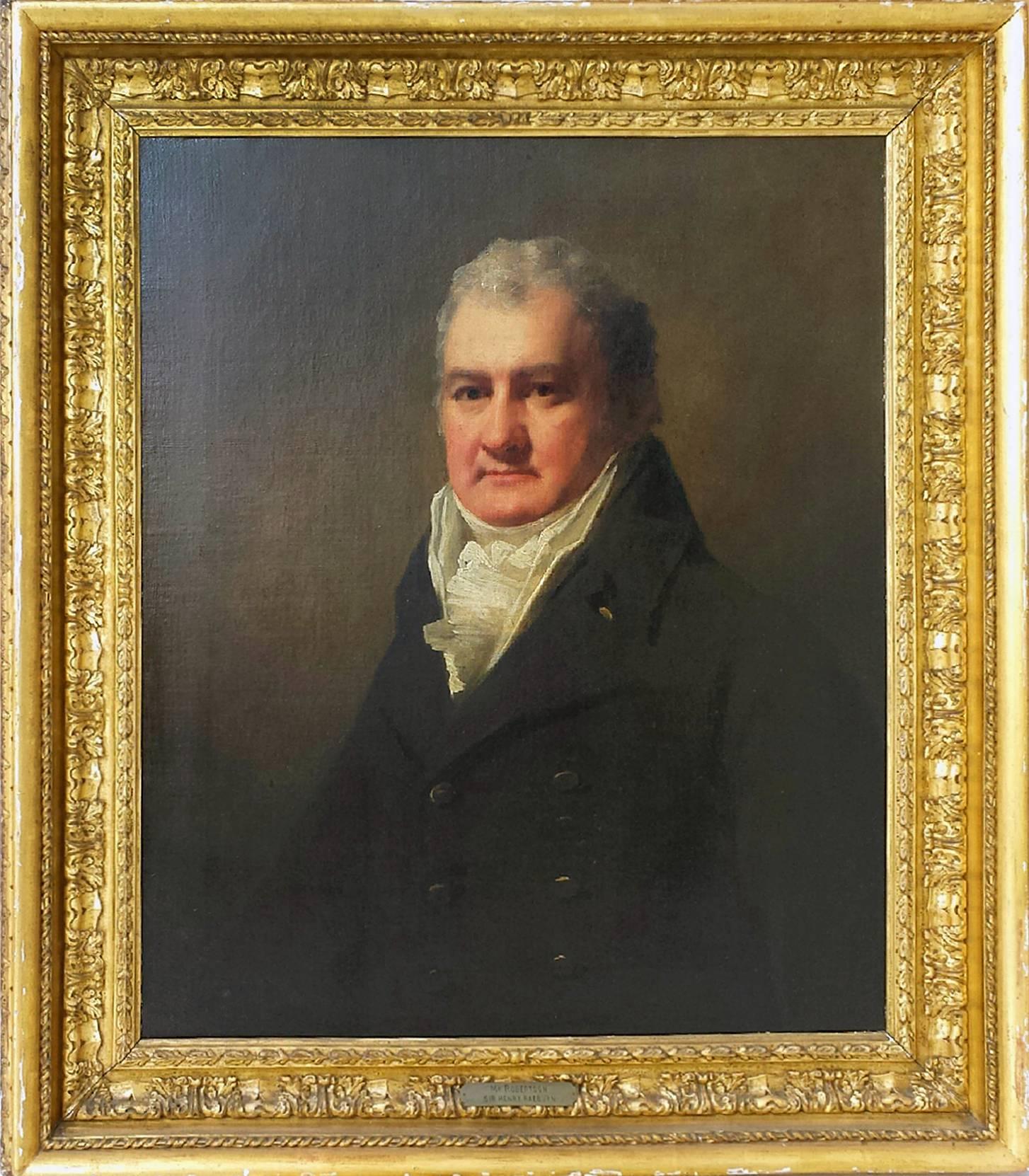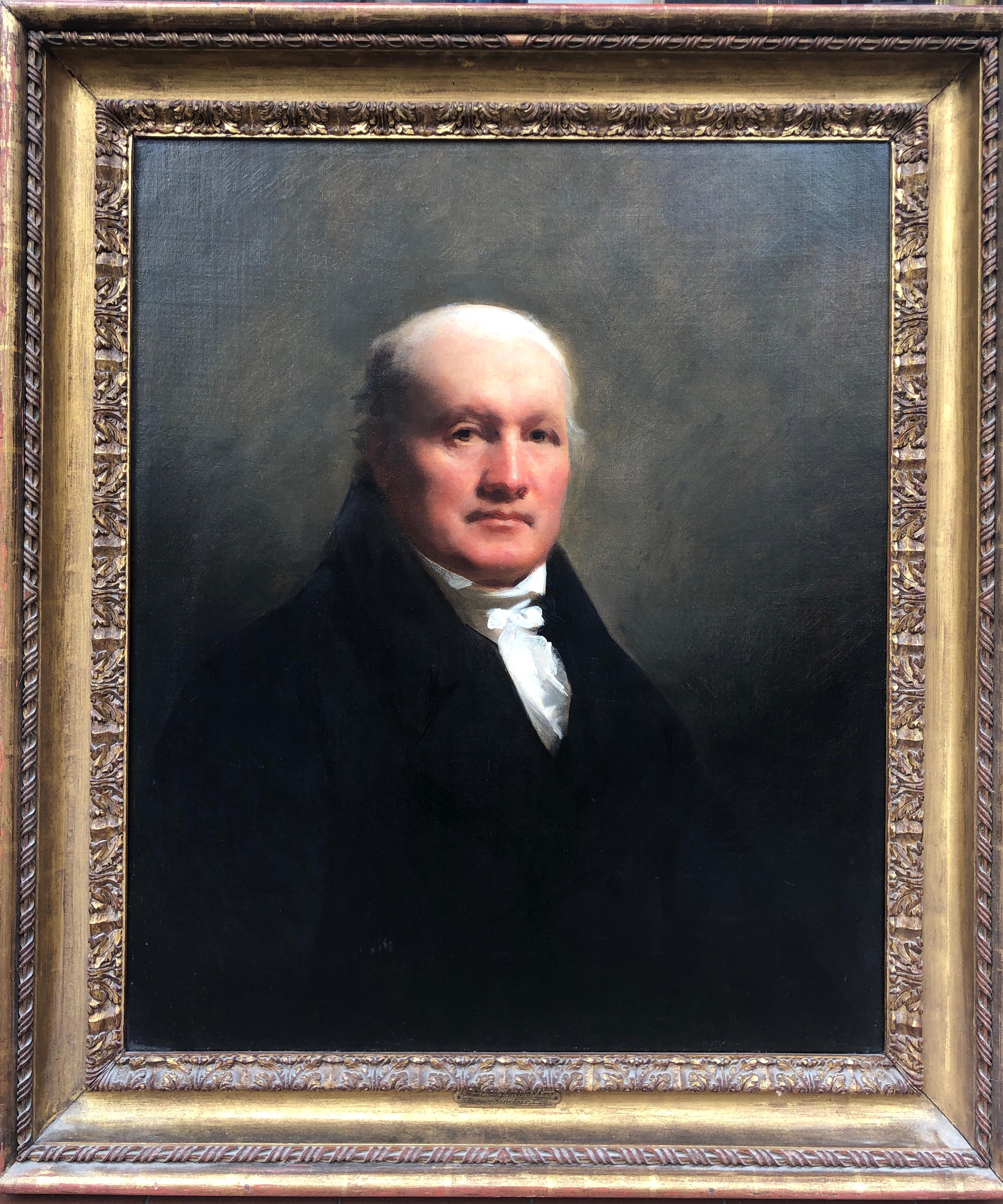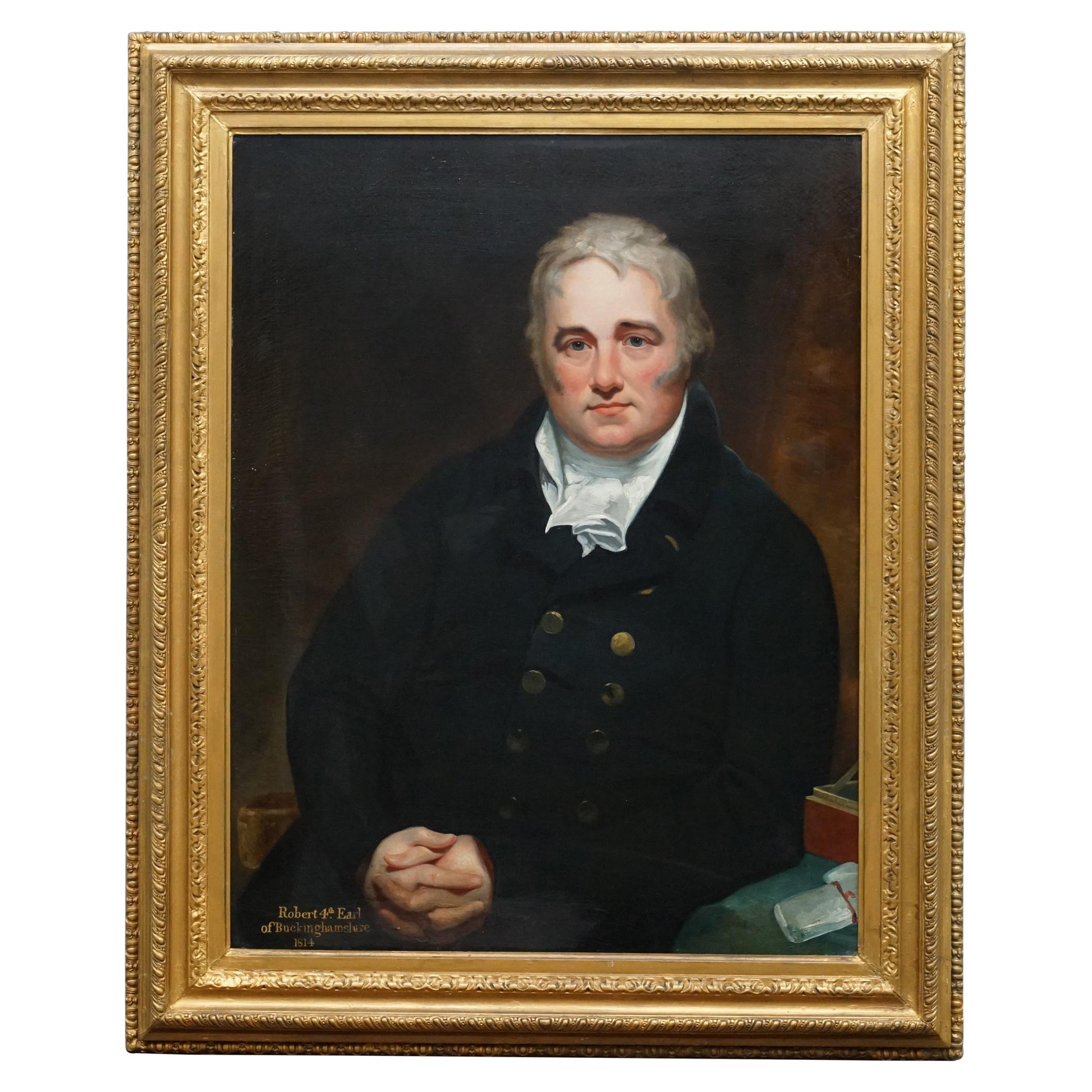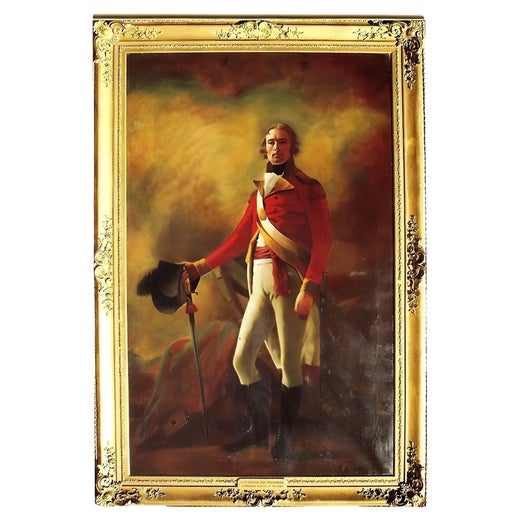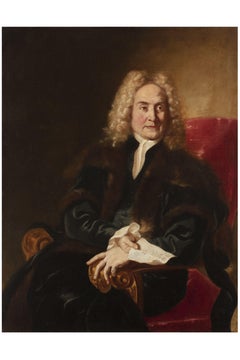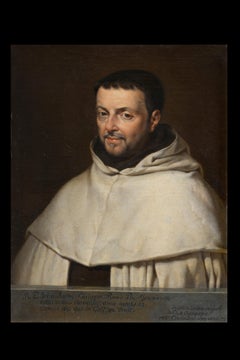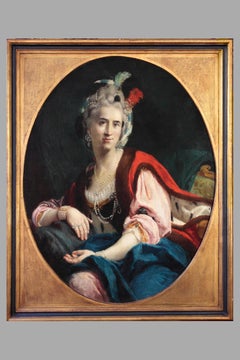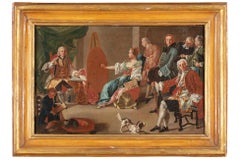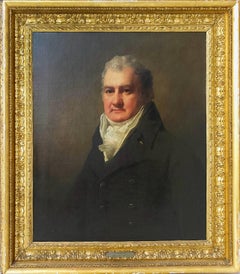Items Similar to 19th Century by Sir Henry Raeburn Portrait of a landowner Oil on canvas
Want more images or videos?
Request additional images or videos from the seller
1 of 8
Sir Henry Raeburn19th Century by Sir Henry Raeburn Portrait of a landowner Oil on canvasEarly 19th century, 1803
Early 19th century, 1803
$37,474.28
$46,842.8520% Off
£27,726.28
£34,657.8520% Off
€31,120
€38,90020% Off
CA$51,814.86
CA$64,768.5820% Off
A$56,886.25
A$71,107.8220% Off
CHF 29,677.68
CHF 37,097.1020% Off
MX$688,402.87
MX$860,503.5820% Off
NOK 371,963.65
NOK 464,954.5720% Off
SEK 350,487.56
SEK 438,109.4420% Off
DKK 236,948.55
DKK 296,185.6920% Off
About the Item
Sir Henry Raeburn (Stockbridge, Edinburgh, UK, 1756 - Edinburgh, UK, 1823)
Title: Portrait of a landowner
Year: Early 19th century, 1803
Medium: Oil on canvas
Dimensions: Without frame 135.5 x 112 cm – with frame 162 x 130.7 cm
Expertise by Benedetta Scaglioni, art historian
Fairs: The International Biennial of Antiques in Florence 2024 (BIAF, Biennale Internazionale dell’Antiquariato di Firenze)
Henry Raeburn was born in 1756 at Stockbridge a former village now within the city of Edinburgh, UK. He was a Scottish portrait painter who even served as such to King George IV in Scotland. He started as an apprentice to the goldsmith James Gilliland of Edinburgh, but he eventually took to the production of carefully finished portrait miniatures. Later he stated with oil painting, which he was self-taught. He spent two years studying in Rome and once he returned to Edinburgh, he began a successful career as a portrait painter.
The portrait presented is unpublished and the subject has not yet been identified. Despite this, the social status of the man depicted is evident from the clothes he wears; the black double-breasted tailcoat with brass buttons, the top hat and walking stick. In the background we can admire a rural landscape where a flock of sheep can be distinguished. The painting has two light sources; natural light coming from the setting sun in the background, and artificial light from above and from the left.
- Creator:Sir Henry Raeburn (1756 - 1823, British)
- Creation Year:Early 19th century, 1803
- Dimensions:Height: 63.78 in (162 cm)Width: 51.46 in (130.7 cm)Depth: 1.58 in (4 cm)
- More Editions & Sizes:Without frame 135.5 x 112 cm – with frame 162 x 130.7 cmPrice: $46,843
- Medium:
- Movement & Style:
- Period:
- Condition:
- Gallery Location:Milano, IT
- Reference Number:1stDibs: LU1701215465632
Sir Henry Raeburn
Sir Henry Raeburn, FRSE, RA, RSA (1756–1823) was a prominent Scottish portrait painter who is now largely credited for the revival of Scottish art in the early 19th century. Born in Stockbridge, Edinburgh, he was orphaned at a young age and subsequently educated at Heriot’s Hospital. He began his career as a goldsmith's apprentice, creating portrait miniatures before transitioning to oil painting, largely self-taught. Raeburn married the wealthy Ann Edgar, which enabled him to study art in Italy, where he was advised by Sir Joshua Reynolds and others. Upon returning to Edinburgh in 1787, Raeburn quickly gained success, painting notable figures like Sir Walter Scott and Dugald Stewart. He became known for his vigorous brushwork, strong characterizations, and dramatic lighting. His direct painting style and refusal to make preparatory sketches set him apart from contemporaries, incorporating elements of Romanticism. He was knighted by King George IV in 1822 and appointed the King’s limner for Scotland. He died in 1823 at his home in Stockbridge, Edinburgh. This distinguished three-quarter length portrait depicts Elizabeth Clough (b. circa 1970-1770s), matriarch of the Clough family of Keighley, West Yorkshire. The piece was commissioned by her son, John Clough (1799–1863), a prominent engineer and industrialist in Keighley. Clough owned and operated Grove Mills, a major worsted spinning and manufacturing facility which employed a significant portion of the local workforce. Elizabeth Clough is portrayed seated in an upholstered armchair, dressed in sober but elegant attire—a dark shawl and a crisp white cap tied beneath her chin. Her direct, steady gaze and flushed cheeks convey quiet strength and maternal dignity. The subdued, neutral background serves to emphasize the face and upper body, while still maintaining an airy and light feel. The face is rendered with sensitive modeling and naturalistic lighting, while the fabric of her garments contain blockier brushstrokes yet do not lose their sensitivity. These characteristics, combined with the information gleaned from the label, place this piece in the tradition of early 19th century Scottish portraiture.
About the Seller
5.0
Gold Seller
Premium sellers maintaining a 4.3+ rating and 24-hour response times
Established in 1964
1stDibs seller since 2021
Typical response time: 1 hour
- ShippingRetrieving quote...Shipping from: Milano, Italy
- Return Policy
Authenticity Guarantee
In the unlikely event there’s an issue with an item’s authenticity, contact us within 1 year for a full refund. DetailsMoney-Back Guarantee
If your item is not as described, is damaged in transit, or does not arrive, contact us within 7 days for a full refund. Details24-Hour Cancellation
You have a 24-hour grace period in which to reconsider your purchase, with no questions asked.Vetted Professional Sellers
Our world-class sellers must adhere to strict standards for service and quality, maintaining the integrity of our listings.Price-Match Guarantee
If you find that a seller listed the same item for a lower price elsewhere, we’ll match it.Trusted Global Delivery
Our best-in-class carrier network provides specialized shipping options worldwide, including custom delivery.More From This Seller
View All17th-18th Century By Niccolò Cassana Portrait of a Gentleman Oil on Canvas
Located in Milano, Lombardia
Niccolò Cassana (Venice, Italy, 1659 - London, UK, 1714)
Title: Portrait of a Gentleman
Medium: Oil on canvas
Dimensions: without frame 119.5 x 92.5 cm
Painting without frame.
Expe...
Category
17th Century Old Masters Portrait Paintings
Materials
Oil, Canvas
19th Century By Comte d'Houdetot Portrait of GiovanniAntonioFilippini Oil/canvas
Located in Milano, Lombardia
Frédéric-Christophe, Comte d'Houdetot (Paris, France, 1778 - 1859)
Title: Portrait of Giovanni Antonio Filippini
Medium: Oil on canvas
Dimensions: without frame 72.50 x 42 cm - with ...
Category
19th Century Old Masters Portrait Paintings
Materials
Canvas, Oil
18th Century By Dalla Rosa Portrait of Angela Guggerotti Fracastoro Oil/Canvas
Located in Milano, Lombardia
Saverio Dalla Rosa (Verona, Italy, 1745 - 1821)
Title: Portrait of Angela Guggerotti Fracastoro
Medium: Oil on canvas
Dimensions: without frame 94 x 73 cm - with frame 105 x 94 cm
Fr...
Category
18th Century Old Masters Portrait Paintings
Materials
Canvas, Oil
18th Century by Giuseppe Bonito The Painter's Studio or Allegory of Painting
Located in Milano, Lombardia
Giuseppe Bonito (Castellammare di Stabia, Italy, 1707 - Naples, Italy, 1789)
Title: The Painter's Studio or Allegory of Painting
Medium: Oil on canvas
...
Category
Mid-18th Century Old Masters Figurative Paintings
Materials
Oil, Canvas
18th Century by Richard Wilson Landscape Oil on canvas
Located in Milano, Lombardia
Richard Wilson (Montgomeryshire, UK, 1714 - Denbigshire, UK, 1782)
Title: Landscape
Medium: Oil on canvas
Dimensions: without frame 33 × 42,5 cm
Painting without frame
Not signed
Ex...
Category
18th Century Old Masters Landscape Paintings
Materials
Canvas, Oil
$29,960 Sale Price
20% Off
18th Century by Alessandro Longhi Portrait of a young musician Oil on canvas
Located in Milano, Lombardia
Alessandro Longhi (Venice, Italy, 1733 – 1813)
Title: Portrait of a young musician in front of his desk with a score in his hand
Medium: Oil on canvas
Dimensions: without frame 39.5 ...
Category
18th Century Old Masters Portrait Paintings
Materials
Canvas, Oil
You May Also Like
Half Length Portrait of Mr. Robertson of Edinburgh
By Sir Henry Raeburn
Located in Miami, FL
Half Length Portrait of Mr. Robertson
Sir. Henry Raeburn ( Scottish 1756 - 1823 )
Half Length Portrait of Mr. Robertson
29x 24
Purchased, J Leger & Son,...
Category
18th Century Realist Portrait Paintings
Materials
Oil
Striking 18th Century Portrait of the 12th Earl of Caithness
By Sir Henry Raeburn
Located in London, GB
Sir Henry Raeburn (1756-1823)
James Sinclair, 12th Earl of Caithness (1766-1823)
Oil on Canvas
30 X 25 inches Unframed
37 X 32 inches framed
Sir Henry Raeburn FRSE RA RSA (4 March 1756 – 8 July 1823) was a Scottish portrait painter and Scotland's first significant portrait painter since the Union to remain based in Scotland. He served as Portrait Painter to King George IV in Scotland.
Raeburn was born the son of a manufacturer in Stockbridge, on the Water of Leith: a former village now within the city of Edinburgh. He had an older brother, born in 1744, called William Raeburn. His ancestors were believed to have been soldiers, and may have taken the name "Raeburn" from a hill farm in Annandale, held by Sir Walter Scott's family. Orphaned, he was supported by William and placed in Heriot's Hospital, where he received an education. At the age of fifteen he was apprenticed to the goldsmith James Gilliland of Edinburgh, and various pieces of jewellery, mourning rings and the like, adorned with minute drawings on ivory by his hand, still exist. Soon he took to the production of carefully finished portrait miniatures; meeting with success and patronage, he extended his practice to oil painting, at which he was self-taught. Gilliland watched the progress of his pupil with interest, and introduced him to David Martin, who had been the favourite assistant of Allan Ramsay the Latter, and was now the leading portrait painter in Edinburgh. Raeburn was especially aided by the loan of portraits to copy. Soon he had gained sufficient skill to make him decide to devote himself exclusively to painting. George Chalmers (1776; Dunfermline Town Hall) is his earliest known portrait.
In his early twenties, Raeburn was asked to paint the portrait of a young lady he had noticed when he was sketching from nature in the fields. Ann was the daughter of Peter Edgar of Bridgelands, and widow of Count James Leslie of Deanhaugh. Fascinated by the handsome and intellectual young artist, she became his wife within a month, bringing him an ample fortune. The acquisition of wealth did not affect his enthusiasm or his industry, but spurred him on to acquire a thorough knowledge of his craft. It was usual for artists to visit Italy, and Raeburn set off with his wife. In London he was kindly received by Sir Joshua Reynolds, the president of the Royal Academy, who advised him on what to study in Rome, especially recommending the works of Michelangelo, and gave Raeburn letters of introduction for Italy. In Rome he met his fellow Scot Gavin Hamilton, Pompeo Girolamo Batoni and Byers, an antique dealer whose advice proved particularly useful, especially the recommendation that "he should never copy an object from memory, but, from the principal figure to the minutest accessory, have it placed before him." After two years of study in Italy he returned to Edinburgh in 1787, and began a successful career as a portrait painter. In that year he executed a seated portrait of the second Lord President Dundas.
Examples of his earlier portraiture include a bust of Mrs Johnstone of Baldovie and a three-quarter-length of Dr James Hutton: works which, if somewhat timid and tentative in handling and not as confident as his later work, nevertheless have delicacy and character. The portraits of John Clerk, Lord Eldin, and of Principal Hill of St Andrews belong to a later period. Raeburn was fortunate in the time in which he practised portraiture. Sir Walter Scott, Hugh Blair, Henry Mackenzie, Lord Woodhouselee, William Robertson, John Home, Robert Fergusson, and Dugald Stewart were resident in Edinburgh, and were all painted by Raeburn. Mature works include his own portrait and that of the Rev. Sir Henry Moncrieff Wellwood, a bust of Dr Wardrop of Torbane Hill, two full-lengths of Adam Rolland of Gask, the remarkable paintings of Lord Newton and Dr Alexander Adam in the National Gallery of Scotland, and that of William Macdonald of St Martin's. Apart from himself, Raeburn painted only two artists, one of whom was Sir Francis Leggatt Chantrey, the most important and famous British sculptor of the first half of the 19th century. It has recently been revealed that Raeburn and Chantrey were close friends and that Raeburn took exceptional care over the execution of his portrait of the sculptor, one of the painter's mature bust-length masterpieces.
It was commonly believed that Raeburn was less successful in painting female portraits, but the exquisite full-length of his wife, the smaller likeness of Mrs R. Scott Moncrieff in the National Gallery of Scotland, and that of Mrs Robert Bell, and others, argue against this. Raeburn spent his life in Edinburgh, rarely visiting London, and then only for brief periods, thus preserving his individuality. Although he, personally, may have lost advantages resulting from closer association with the leaders of English art, and from contact with a wider public, Scottish art gained much from his disinclination to leave his native land. He became the acknowledged chief of the school which was growing up in Scotland during the early 19th century, and his example and influence at a critical period were of major importance. So varied were his other interests that sitters used to say of him, "You would never take him for a painter till he seizes the brush and palette."
In 1812 he was elected president of the Society of Artists in Edinburgh; and in 1814 associate, and in the following year full member, of the Royal Scottish Academy. On 29 August 1822 he was knighted by George IV and appointed His Majesty's limner for Scotland at the Earl of Hopetoun house. He died in Edinburgh.
Raeburn had all the essential qualities of a popular and successful portrait painter. He was able to produce a telling and forcible likeness; his work is distinguished by powerful characterisation, stark realism, dramatic and unusual lighting effects, and swift and broad handling of the most resolute sort. David Wilkie recorded that, while travelling in Spain and studying the works of Diego Velázquez, the brushwork reminded him constantly of the "square touch" of Raeburn. Scottish physician and writer John Brown wrote that Raeburn "never fails in giving a likeness at once vivid, unmistakable and pleasing. He paints the truth, and he paints it with love".
Raeburn has been described as a "famously intuitive"portrait painter. He was unusual amongst many of his contemporaries, such as Reynolds, in the extent of his philosophy of painting directly from life; he made no preliminary sketches. This attitude partly explains the often coarse modelling and clashing colour combinations he employed, in contrast to the more refined style of Thomas Gainsborough and Reynolds. However these qualities and those mentioned above anticipate many of the later developments in painting of the 19th century from romanticism to Impressionism.
Sir Henry Raeburn died in St Bernard's House (17 St Bernards Crescent), Stockbridge, Edinburgh. He is buried in St. Cuthbert's churchyard against the east wall (the monument erected by Raeburn in advance) but also has a secondary memorial in the Church of St John the Evangelist, Edinburgh.
James Sinclair, 12th Earl of Caithness was born at Barrogill Castle (Castle of Mey) on 31 May 1766. He was the son of Sir John Sinclair of Mey, Baronet who he succeeded in the baronetcy in 1774. He succeeded as 12th earl of Caithness in 1789.
He was lord-lieutenant of the county of Caithness and lieutenant-colonel of the Ross-shire militia.
He married at Thurso Castle on 2 January 1784 Jane, second daughter of Alexander Campbell...
Category
18th Century Portrait Paintings
Materials
Oil
$29,778 Sale Price
40% Off
Free Shipping
Henry Raeburn, (circle) 19th Century portrait of Sir Charles Forbes Edinglassie
By Henry Raeburn (circle)
Located in York, GB
Portrait of Sir Charles Forbes of Edinglassie, Oil on canvas.
The size of the portrait is 75 cm x 59.5 cm whilst overall the size is 106 cm x 91 cm
In very good condition.There has been some restoration/overpainting etc.There is some minor craquelure.
Housed in a period gilt frame decorated with acorns and leaves
Overall a good portrait, circle of a fine scottish artist (unsigned) , with an interesting sitter, his details below.
sir Charles Forbes of Edinglassie
Sir Charles Forbes, 1st Baronet (1774–1849) was a Scottish politician, of Newe and Edinglassie, Aberdeenshire. Forbes was the son of the Rev. George Forbes of Lochell. He was a descendant of Alexander Forbes of Kinaldie and Pitsligo, and was in 1833 served heir male in general to Alexander Forbes, 3rd lord Forbes of Pitsligo, father of Alexander Forbes, 4th Lord Forbes of Pitsligo, attainted in 1745.
Forbes was of a bluff but kindly nature, diffident as to his own merits, of a straightforward and manly character. On the death of his uncle in 1821 Forbes succeeded to the entailed estates of the Forbeses of Newe, and was created a baronet by patent in 1823.[1] He married in 1811. His daughter, Elizabeth, married General, Lord James Hay, second son of the seventh Marquess of Tweeddale.
Sir Henry Raeburn FRSE, RA, RSA (1756-1823)
Scottish portrait painter and Scotland's first significant portrait painter
since the Union to remain based in Scotland.
He served as Portrait Painter to King George IV in Scotland
Raeburn had all the essential qualities of a popular and successful portrait painter.
He was able to produce a telling and forcible likeness;
his work is distinguished by powerful characterisation,
stark realism, dramatic and unusual lighting...
Category
19th Century Old Masters Portrait Paintings
Materials
Oil
$5,507 Sale Price
33% Off
Free Shipping
Portrait of a Seated Gentleman - British 19th century art portrait oil painting
By Thomas Lawrence (circle)
Located in Hagley, England
This striking British 19th century portrait oil painting is attributed to the circle of Sir Thomas Lawrence. Painted circa 1820 it is the portrait of a seated gentleman in a brown hi...
Category
Early 19th Century Realist Portrait Paintings
Materials
Oil
Lady Eleanor Dundas - Old Master 18C Scottish art oil painting female portrait
By Henry Raeburn (circle)
Located in Hagley, England
A fine large and stunning Scottish Old Master portrait oil painting on canvas portrait in good condition which depicts Lady Eleanor Dundas in a white dress set against an open landsc...
Category
19th Century Old Masters Portrait Paintings
Materials
Oil
1814 SIR WILLIAM BEECHEY CIRCLE OIL PAINTING ROBERT 4TH EARL OF BUCKINGHAMSHiRE
Located in West Sussex, Pulborough
Wimbledon-Furniture
Wimbledon-Furniture is delighted to offer for sale this stunning oil painting portrait, signed to the bottom left Robert 5th Earl of Buckinghamshire 1814 and printed to the back “prepared by Roberson & Miller 51 Long Acre London” the painting is the circle of Sir William Beechey
Please note the delivery fee listed is just a guide, it covers within the M25 only for the UK and local Europe only for international, if you would like an accurate quote please send me your postcode and I’ll provide you with the exact price
A very attractive portrait of Robert seated at his desk in rather stately looking attire. The frame is the original gilt wood and quite an expensive piece on its own
The condition is very good, it is over 200 years old so there will be touch ups and restorations that have occurred, there is no damage to note that I can see or feel
Dimensions
Height:- 112.5cm
Width:- 92cm
Depth:- 7cm
This painting as mentioned is the circle of Sir William Beechey
Sir William Beechey RA (12 December 1753 – 28 January 1839) was a leading English portraitist during the golden age of British painting.
Early life
Beechey was born at Burford, Oxfordshire, on 12 December 1753, the son of William Beechey, a solicitor, and his wife Hannah Read. Both parents died when he was still quite young, and he and his siblings were brought up by his uncle Samuel, a solicitor who lived in nearby Chipping Norton. The uncle was determined that the young Beechey should likewise follow a career in the law, and at an appropriate age he was entered as a clerk with a conveyancer near Stow-on-the-Wold. But as The Monthly Mirror later recorded in July 1798, he was: "Early foredoomed his [uncle's] soul to cross/ And paint a picture where he should engross."
Beechey was admitted to the Royal Academy Schools in 1772, where he is thought to have studied under Johan Zoffany. He first exhibited at the Academy in 1776. His earliest surviving portraits are small-scale full-length and conversation pieces which are reminiscent of Zoffany.
In 1782, he moved to Norwich, where he gained several commissions, including a portrait of Sir John...
Category
Antique 1810s English Regency Paintings
Materials
Canvas, Giltwood
More Ways To Browse
Antique Portrait Miniature
Top Hat Antique
Oil Painting With Brass Frame
Antique Brass Buttons
Antique Miniature Oil Paintings
Crime And Punishment
Cubist Face Painting
Flapper Painting
John Vanderbank
Mayer Mid Century Painting
Mick Jagger Painting
Oil Portrait Tina
Okamura Arthur
Queen Mary Of Scots Portrait
Renaissance Woman Painting
Sara Scribner
Small Oil Portrait
Used Satellite Dish
